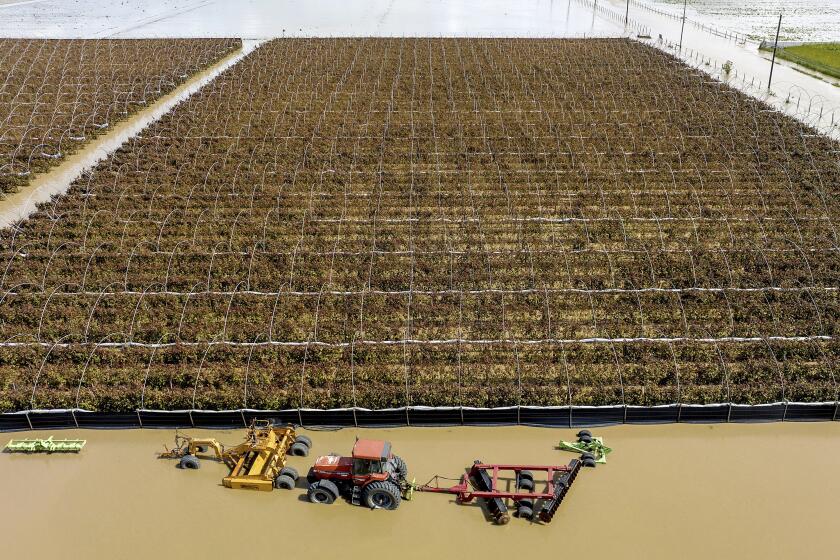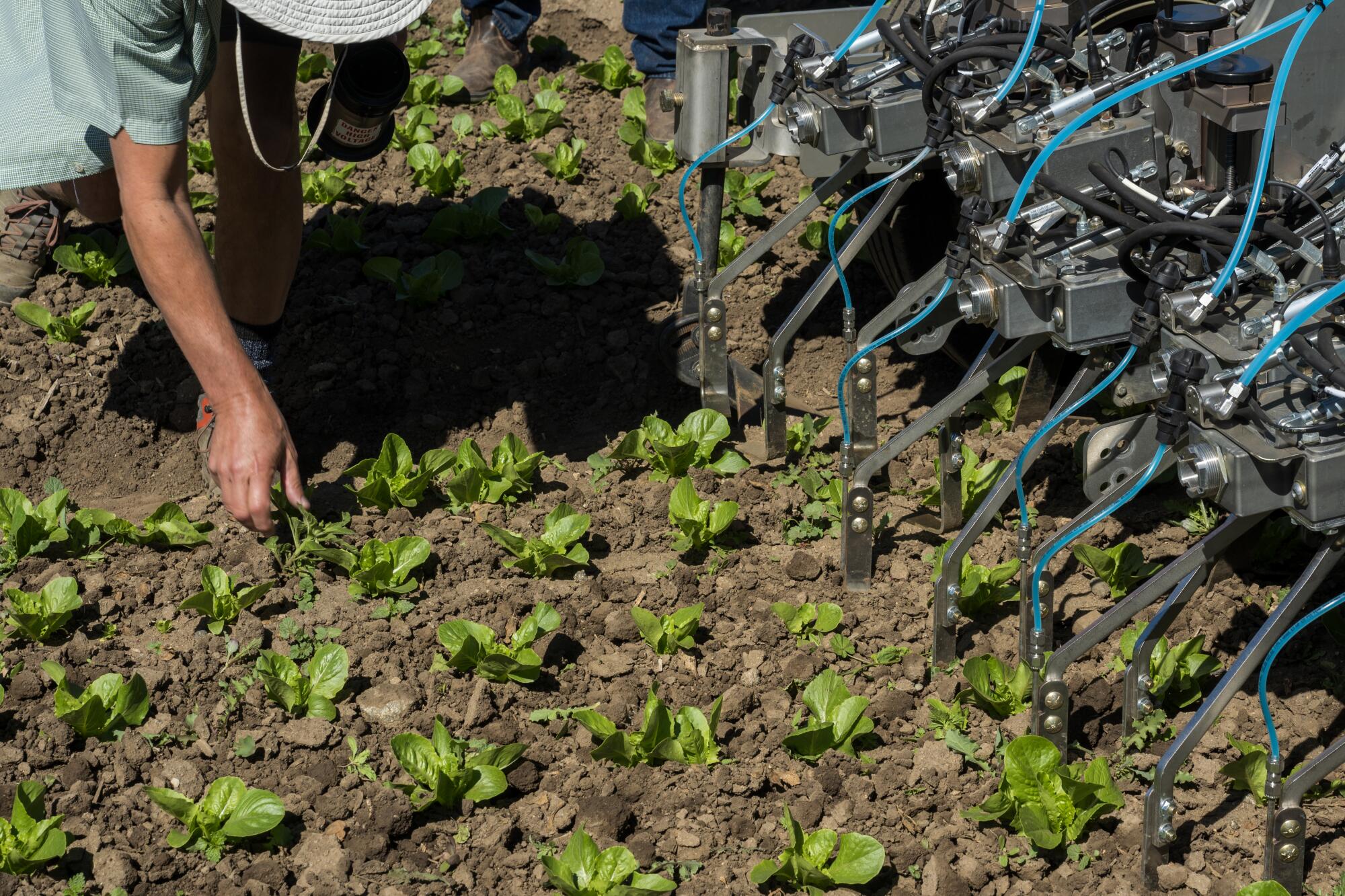
- Share via
SALINAS, Calif. — The smell of burnt vegetation wafted through a lettuce field here one recent summer morning as nearly 200 farmers, academics and engineers gathered to witness the future of automated agriculture.
Thirteen hulking machines with names like “Weed Spider” and “Mantis” crawled through rows of romaine. One used artificial intelligence cameras to scan the crops and spray them with herbicides. Another zapped weeds with lasers. Yet another deployed robotic arms to cultivate and pick through the foliage.
“It’s a hurdle for people to get over, but the reality is, the numbers don’t lie,” said Tim Mahoney, a field representative for Carbon Robotics, a Seattle-based company that created one of the machines on display — a 9,500-pound apparatus known as the LaserWeeder.
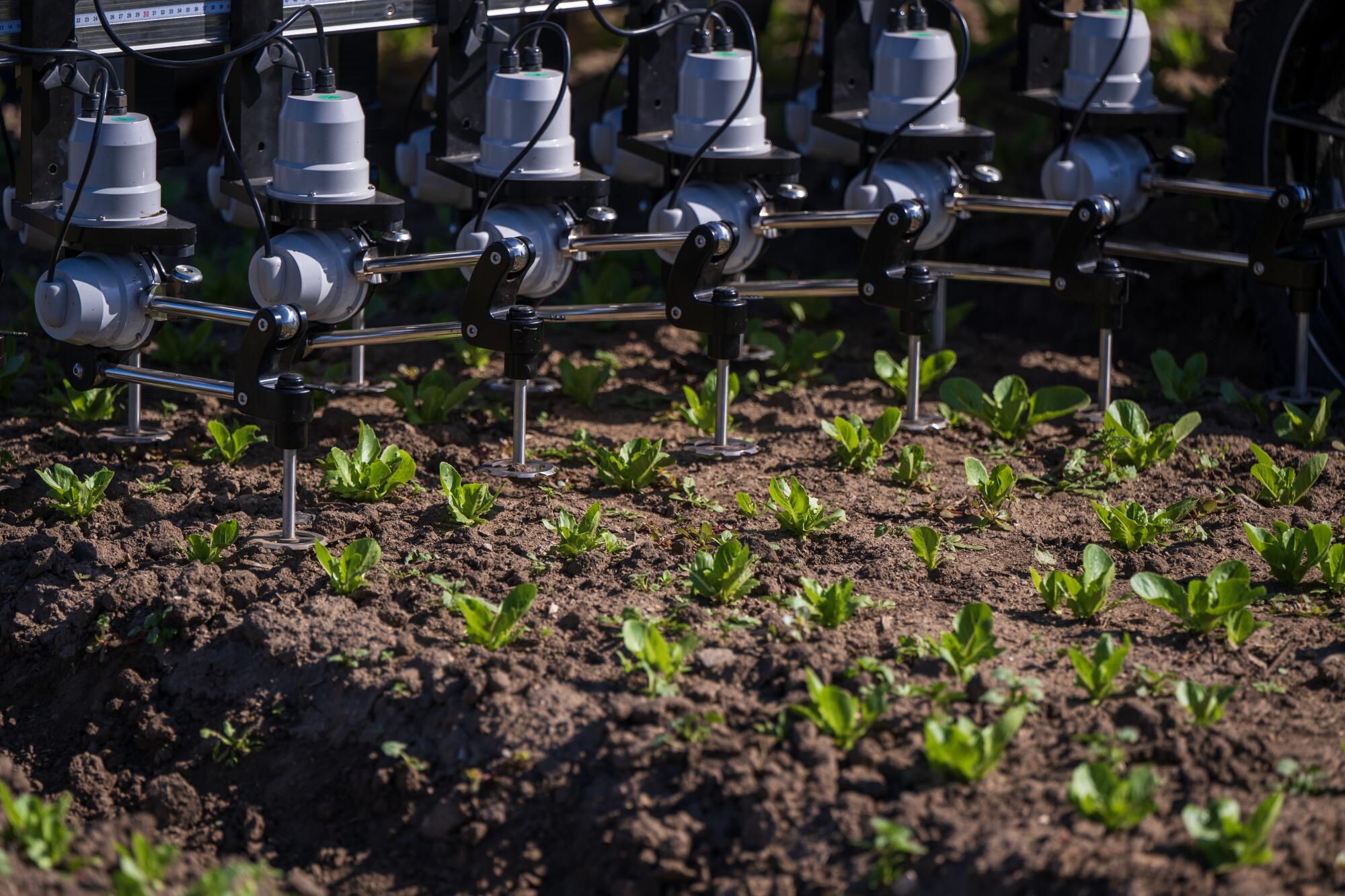
The massive machine uses deep-learning AI models to scan fields and identify weeds in real time before vaporizing them with more than 30 high-powered lasers, all while protecting the crop. The company says it reduces farming costs, increases yields and improves soil health while avoiding the need for chemical herbicides.
“This is the future,” Mahoney said as the LaserWeeder moved through the lettuce, leaving small wisps of smoke in its wake.
Aggressive and impactful reporting on climate change, the environment, health and science.
The high-tech field day comes at a moment when Californians are strongly reconsidering their relationship with traditional herbicides and pesticides. Chemicals such as paraquat, dacthal and glyphosate — also known as RoundUp — have for decades been used to eliminate weeds and pests from the state’s crops, but are increasingly associated with cancer, Parkinson’s disease, kidney disease, respiratory ailments and birth defects, among other potential health risks.
Steven Fennimore, a weed researcher and professor of plant sciences at UC Davis, said the industry’s technological shift arrives as state regulators are “weeding out the old stuff.” Assembly Bill 1963 — a bill seeking to ban the use of paraquat in California — is working its way through the state Legislature and will be heard by the Senate Appropriations committee in August.
What’s more, the California Department of Pesticide Regulation last year released a roadmap for sustainable pest management that aims to transition the state away from harmful chemicals and toward safer, organic alternatives by 2050.
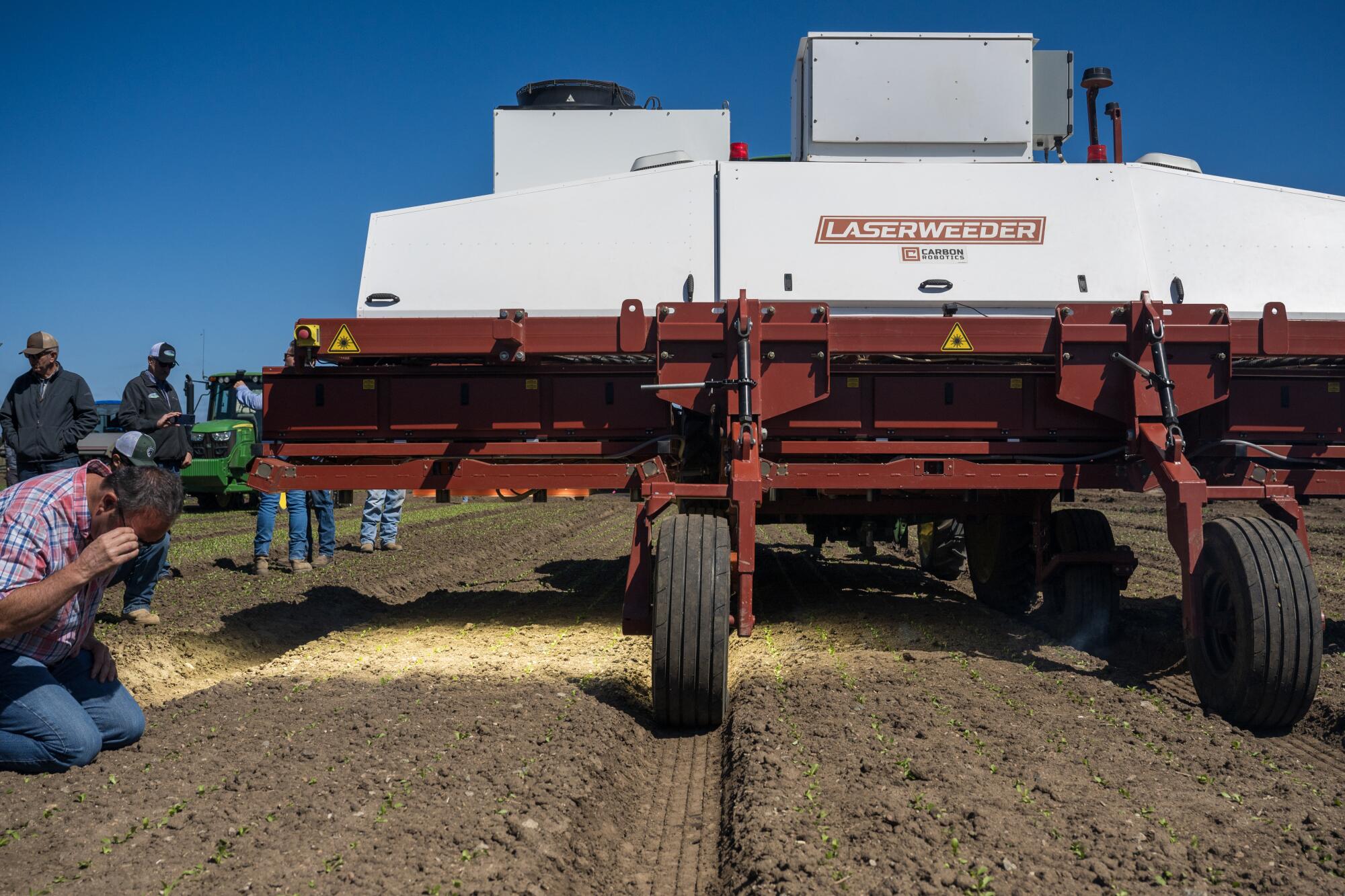
Fennimore, who organized the field day in Salinas, said many of the state’s most popular herbicides and pesticides have been around for more than half a century and come with considerable baggage despite their effectiveness. Dacthal was first registered for use in the United States in 1958, paraquat in 1964 and glyphosate in 1974.
Machines enhanced with AI and robotics can help solve many of the same problems without the use of antique sprays and pollutants, he said.
“We’re not getting a lot of new pesticides because the path to commercialization is a whole lot different than it was in 1958 — it’s much more expensive, the toxicology has to be pristine, you can’t injure wildlife in any way,” Fennimore said. “So the machine vision products that are weeding are very much welcome, very much needed.”
Mahoney, of Carbon Robotics, said the company is selling about one $1.4-million LaserWeeder per week, with more than 80 on the market worldwide already. Some customers run it 24 hours a day, including one grower who has it programmed for more than 40 individual crops, he said.
He added that the weeder can zap thousands of weeds per minute, compared with the roughly 40 weeds per minute that can be picked by hand.
“It’s kind of like a Swiss Army knife,” Mahoney said.
Assembly Bill 1963 would sundown the use of the herbicide paraquat, which has been linked to Parkinson’s disease and other health issues, beginning in January 2026.
A shift from herbicides and manual labor to intelligent robots would have far-reaching consequences for California’s $50-billion agriculture industry and local economies.
The potential loss of hand crews is raising concerns. In Monterey County, where Salinas is located, agriculture accounts for nearly a quarter of all jobs and represents the largest employment sector by far, ahead of both government and tourism, according to county data.
Some experts fear the new technology could eliminate farm positions without offering suitable replacements.
“It’s going to be a whole mixed bag of complications,” said Barbara Meister, a consultant with the Salinas Inclusive Economic Development Initiative, who also attended the field day.
“This weeder is an example of replacing human labor with mechanical labor,” Meister said as she pointed to one of the machines. “So for us, we’re thinking about, does this technology enhance labor, replace labor, or create new job opportunities?”
Chris Benner, director of the Institute for Social Transformation at UC Santa Cruz, likened the new tools to the mechanical tomato harvester, which displaced some 30,000 farm jobs when it was first introduced in the 1950s, but also ushered in a new era of industrialized food production.
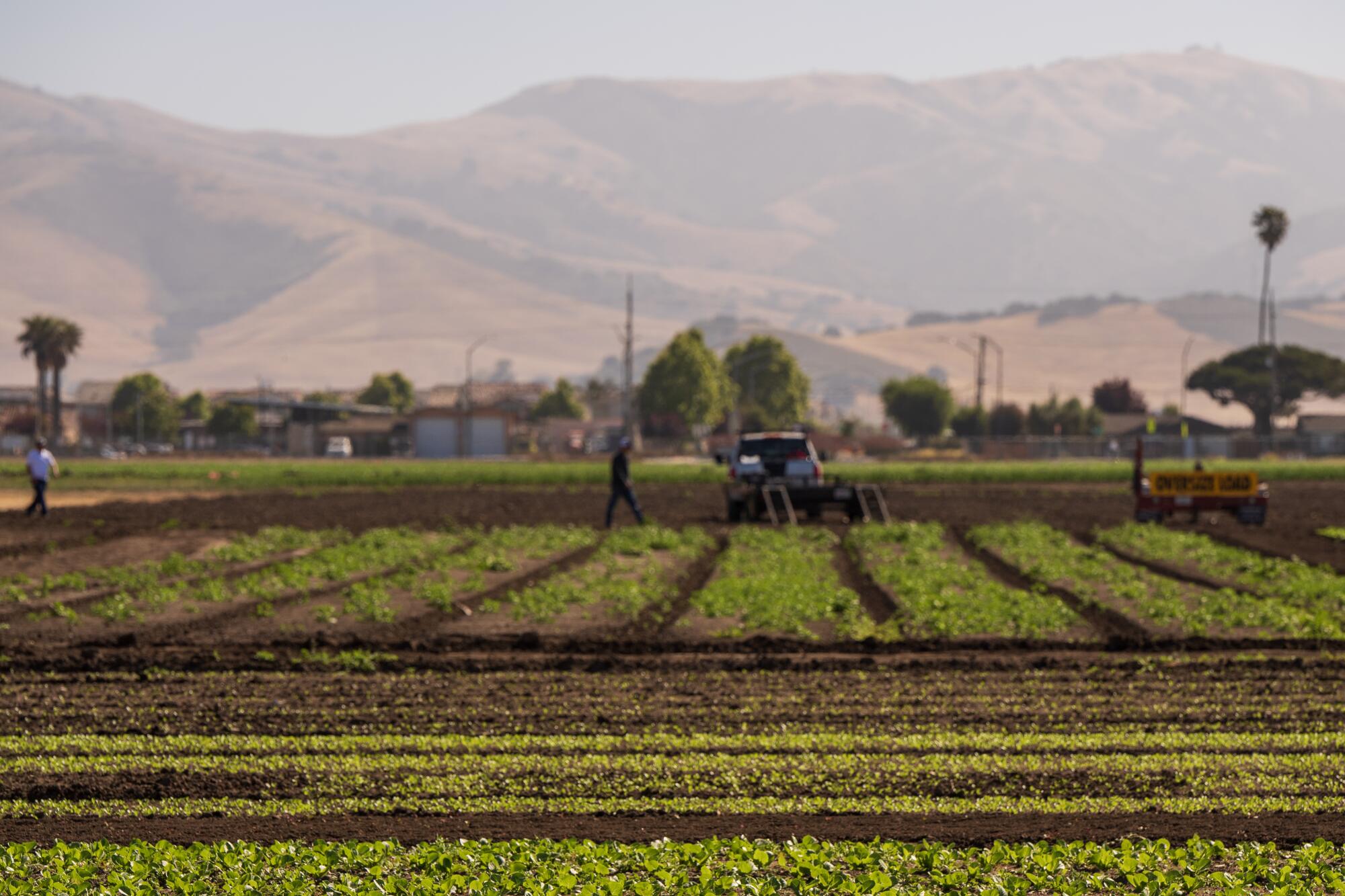
“We need more efficiencies in agriculture to improve profit margins and be able to pay workers in the field more, but that’s ultimately going to displace some people,” Benner said. “What do we do, in that context, to support people who need new training into other types of jobs? The social challenges are much harder than the technical training challenges.”
But agriculture is also facing a shortage of labor. Multiple farmers at the field day said they’re having a tough time finding workers to pick weeds and crops — a tedious and challenging job that often offers only short seasons and minimum wage. The work can also be dangerous, especially when it involves applying potentially toxic chemicals to plants, or toiling in extreme heat.
Pete Anecito, a director of farming with Sábor Farms, said his team is already running a LaserWeeder around the clock, which is being used on spinach mixes and other high-density plantings. It performs the work of roughly two human crews in a 24-hour period, he said.
“All of them lend themselves to different applications that are going to save us time and money,” Anecito said as he checked out the new machines. “These are great trials out here. We need to see what it does to the operation.”
A teachers’ union and community groups in Monterey County have sued agriculture officials and state regulators over the use of pesticides near schools.
While experts continue to weigh the labor implications, the environmental benefits of the technology are much clearer, according to Fennimore.
“We’re not using herbicides, not using pesticides, not using fumigants,” he said. He noted that one machine his team is working on — a smart steamer that sterilizes soil — can be used near schools, where people don’t want “nasty chemical stuff.”
In fact, a coalition of environmental groups, social justice organizations and teachers sued Monterey County agriculture officials and state pesticide regulators in April, alleging the use of restricted pesticides in close proximity to three elementary schools.
“This stuff does serious damage, sometimes permanent damage, and the worst part is it can take decades — if ever — for our regulators to act on this, and that’s the pattern we have to disrupt,” said Mark Weller, a campaign director with Californians for Pesticide Reform, one of the groups involved in the suit.
The use of such chemicals can amount to a form of environmental racism, he said, because the people most likely to be exposed to and sickened by herbicides and pesticides are often low-income people, Latinos, migrant farm workers and other vulnerable populations.
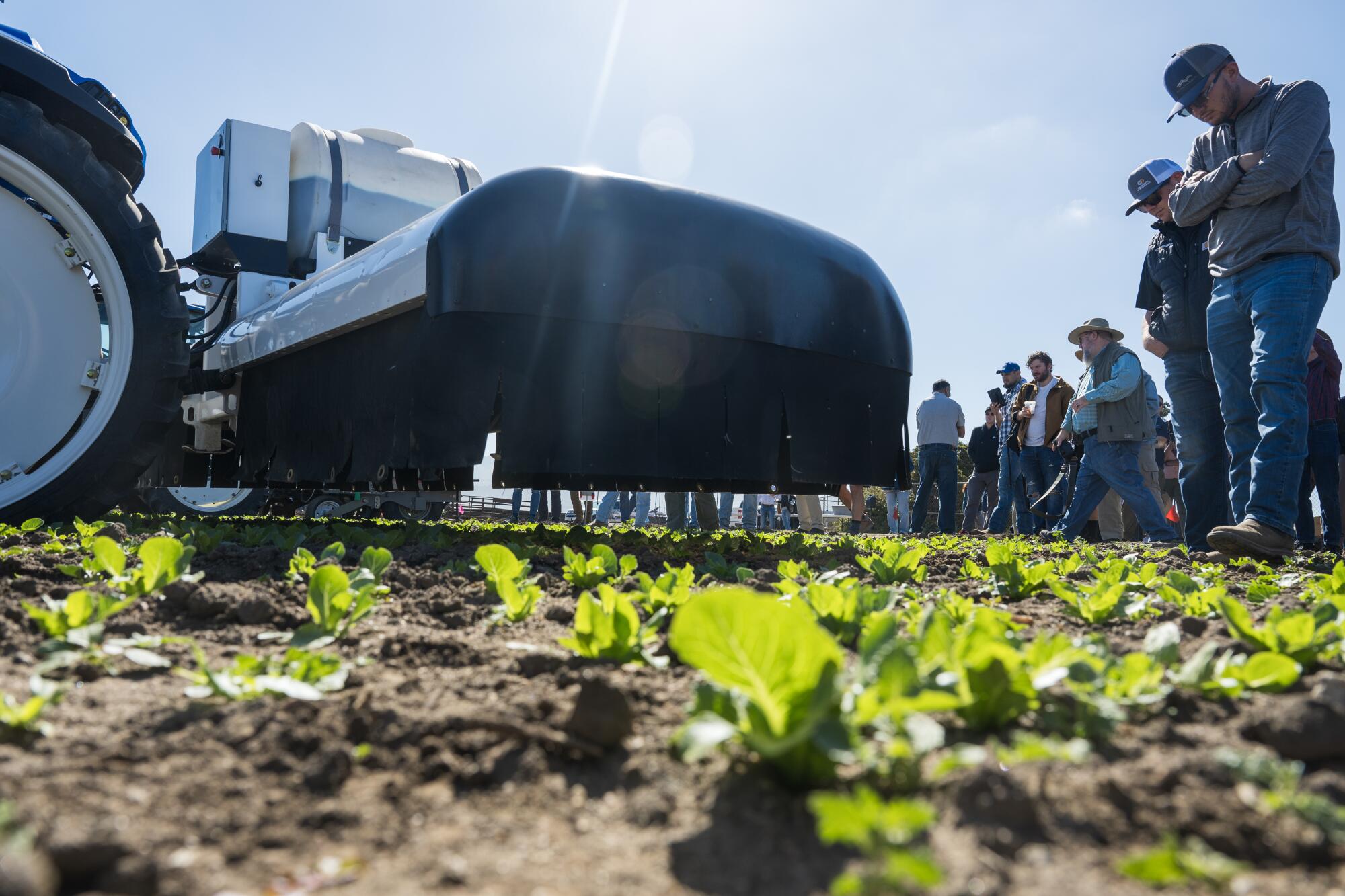
Weller noted that there are more than 130 pesticides used in California that are not approved in the European Union, including paraquat, which is banned in about 60 countries. However, the group’s call for pesticide reform is not focused on artificial intelligence, but rather organic agriculture and integrated weed management strategies, many of which are outlined in the state’s 2050 roadmap.
Among the strategies Weller recommended are inter-row hoeing, which helps suppress weeds; thermal weeding, which uses heat to kill weeds; and bio-herbicides, which use microorganisms for weed control.
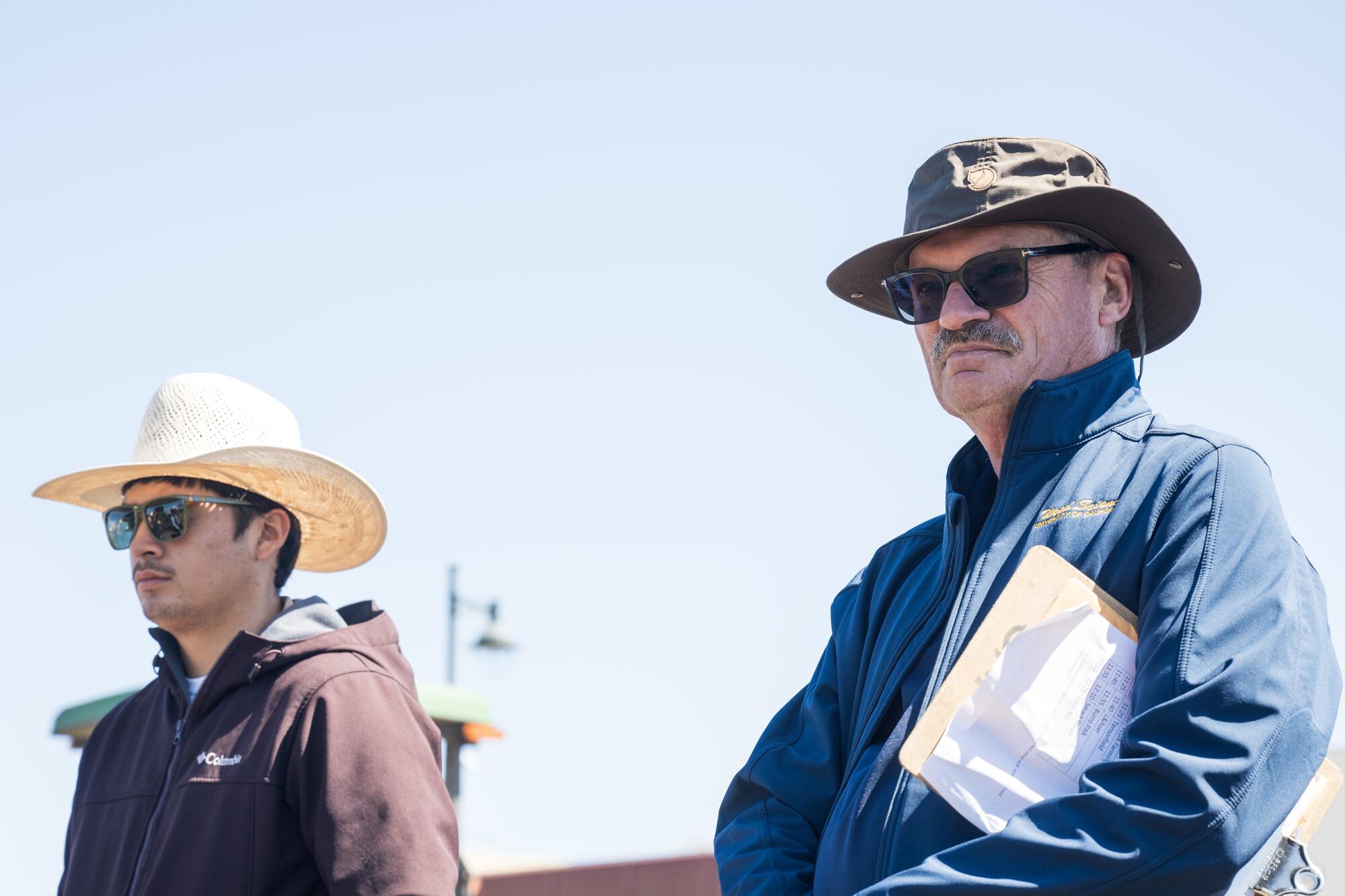
There is also growing interest in replacing herbicides and pesticides at the molecular level. One recent study published in the journal Nature highlighted the ways in which nanotechnology typically used in the medical field could be used to deliver pesticides, herbicides and fungicides to specific biological targets in plants where infections and other issues can occur.
“There’s a whole field of integrated weed management that existed before pesticides, and exists all across the world,” Weller said. “So it’s increasingly frustrating to hear ‘Big Ag’ and the regulators saying there’s no substitute.”
Indeed, many agricultural companies are resistant to change since their products are still effective and profitable, Fennimore said. Syngenta, a leading manufacturer of paraquat, raked in a reported $32 billion in sales in 2023, according to its annual report.
The industry is also filled with deep pockets and powerful lobbyists, which can make it difficult to bring about significant change. But while the companies that created the original products may feel threatened by new AI innovations, “it really doesn’t matter what they think,” Fennimore said.
“The ag-chem companies — they understand that they’re really not parties to this development,” he said. “And they they see the old chemistry under fire and it causes them lots of worry.”
Despite health concerns, paraquat continues to be a popular herbicide in California and other parts of the United States. Some hope to see it banned.
Still, AI farming technology has a ways to go, according to Brad Hanson, an herbicide researcher with the UC Davis Department of Plant Sciences.
Robots and lasers that work on 30,000 acres of lettuce or broccoli may not yet be applicable or economical for millions of acres of soybeans, he said. However, their appeal is growing.
“There’s interest and there’s opportunity,” he said. “[With] high labor costs, environmental and toxicity issues with poured herbicides, regulatory challenges more broadly in California, this kind of thing is becoming important — and will become even more important.”
At the field day in Salinas, it was clear that innovation is marching steadily forward.
In one row, growers used a joystick to operate a Lego-like, $25,000 modular robot on wheels that can be coded for use as a cultivator, a seeder, a data collector, or whatever else is needed on the field, according to its creator, a group called Farm-NG.
Nearby, a metal behemoth from the company Laudando & Associates looked like a Tesla Cybertruck as it combed through a field deploying lasers for weeding and thinning. Next to it, a smart cultivator from Stout Industrial displayed its use of AI vision and mechanical blades to remove weeds from around the crops.
Following each display, a crowd of growers and researchers squatted in the rows to examine the machine’s work, murmuring among themselves about charred leaves or disrupted dirt. Representatives from each company touted their product’s benefits over a megaphone.
A spokesman from Greentech Robotics, which created the WeedSpider, said the 2,000-pound machine was using LIDAR sensors to create a 3-D elevation profile of the field in real time, which could be used for mechanical weeding, thinning or precision spraying. The device can service up to 28 acres a day, he said.
And, like most AI tools, it is constantly learning as it goes.
“Every machine out in the field is always improving,” he said, as the robot’s mechanical arms sifted through the soil behind him.
Toward a more sustainable California
Get Boiling Point, our newsletter exploring climate change, energy and the environment, and become part of the conversation — and the solution.
You may occasionally receive promotional content from the Los Angeles Times.


